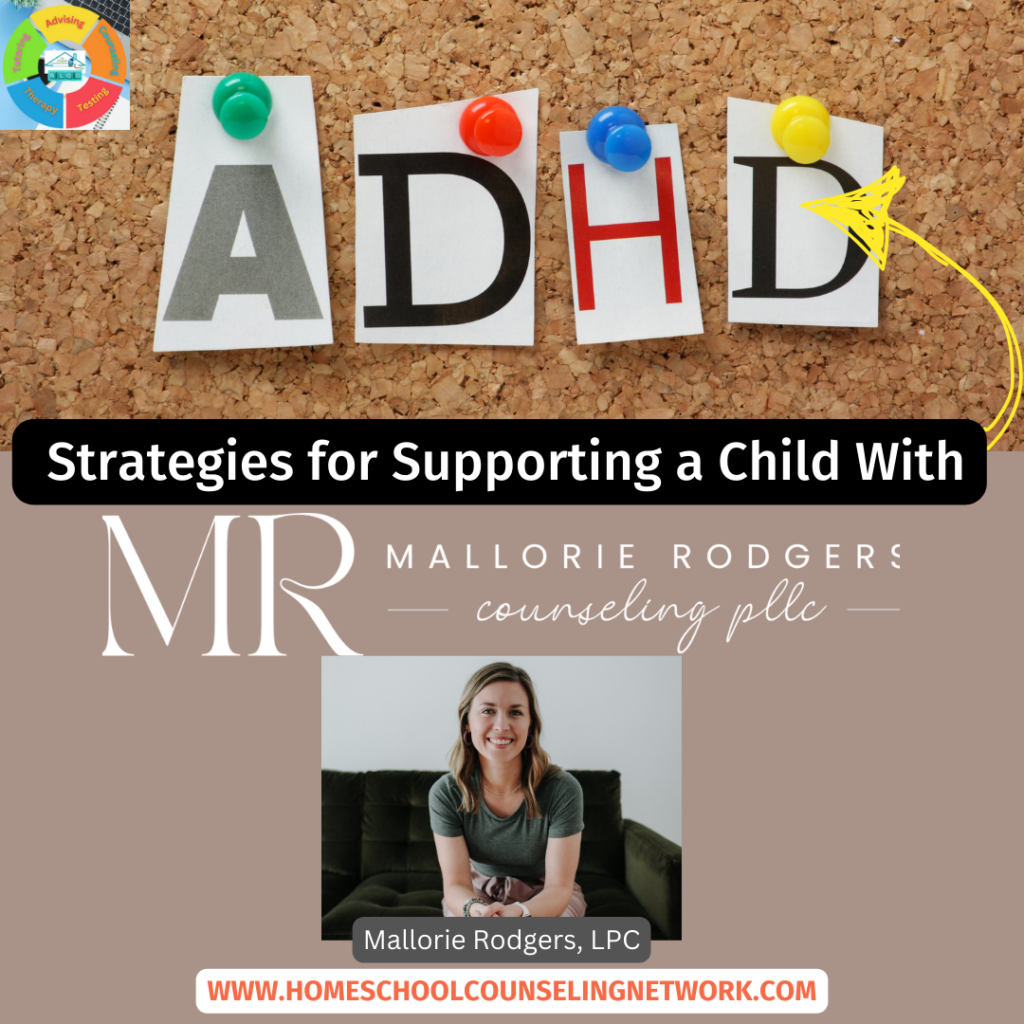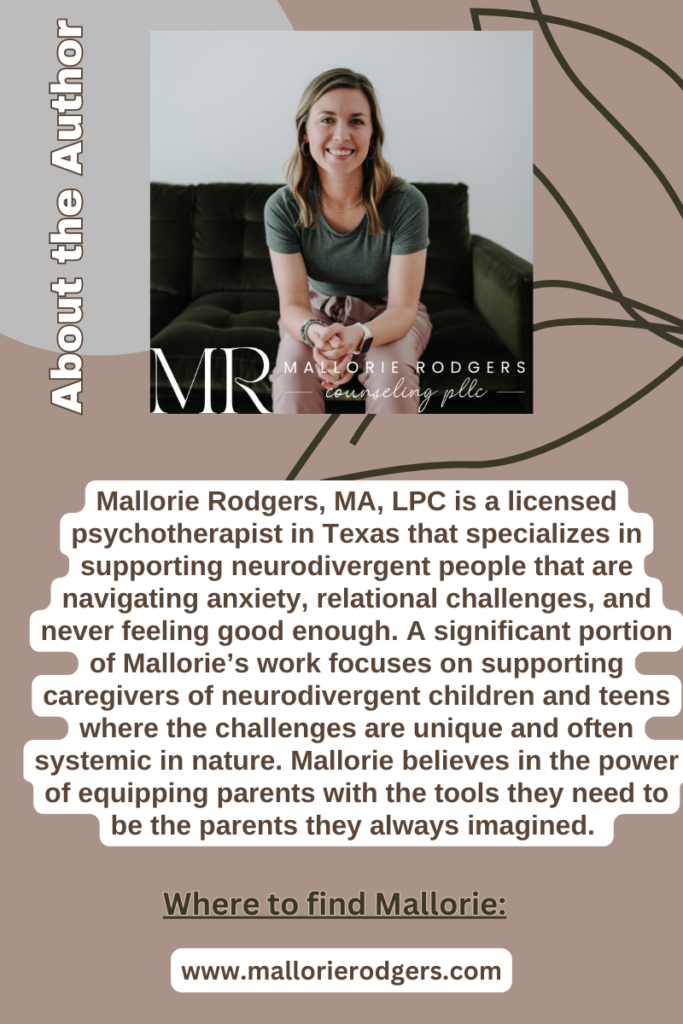HCN Guest Blogger and Psychotherapist Mallorie Rodgers Offers Strategies for Supporting A Child With ADHD
October is ADHD Awareness Month. HCN Guest Blogger and Psychotherapist Mallorie Rodgers has some useful strategies to support families who are homeschooling children with ADHD.
You Know Something Is Different
One of the unique gifts of parenting is the opportunity to know your kids deeply. You can usually tell early on when something about your child seems different from their peers, or their siblings.
In this blog post, we’ll discuss how to support your child if the differences you’re noticing seem to align with the symptoms of ADHD.
Before we continue, I wanted to offer a quick note on the language we use to talk about ADHD children.
Many people in the neurodivergent community now prefer what is called identity-first language (ADHDer or ADHD child), as opposed to person-first language (child with ADHD).
Because of this, I like to ask each individual person what term they prefer. Since I cannot ask you or your child about your unique preference, I will flip-flop between the two.

Signs of ADHD in Children
There are three presentations of ADHD:
- Hyperactive – This is the stereotypical presentation of ADHD. Often, hyperactive kids struggle to sit still for long periods, have boundless energy, talk nearly constantly, appear highly impatient, and may act impulsively.
- Inattentive – This is the most missed presentation of ADHD. ADHDers with an inattentive presentation may seem able to sit still and focus on the outside, but inside their minds, they are all over the place. Some symptoms to look for are: easily distracted; forgetfulness; organization systems that don’t make sense to anyone but the ADHDer; low self-worth; and difficulty with task initiation.
- Hyperactive/Inattentive (Combined) – This presentation is simply a combination of the previous two.
Across the board, many ADHDers struggle with executive processing skills like time management, organization, forgetfulness, and follow-through. Additionally, it is common to observe low self-worth, social challenges, and emotion regulation difficulties in kids with ADHD.
A Note on Masking and Gender Bias
It is important to note that boys have previously been more likely to be diagnosed with ADHD. In contrast, girls would either be missed for the diagnosis, or diagnosed with something else entirely (potentially misdiagnosed). Many of these girls grow up to be what we call late-diagnosed in that they are adults before they receive their diagnosis.
Previously, ADHD diagnostic criteria were strictly for the hyperactive/impulsive presentation (named ADD at the time). Now that we know inattentiveness is a large component of ADHD for many people, the diagnostic name and criteria have widened to include more girls given their specific presentations.
It’s important to mention that girls are typically socialized to be more compliant, quiet, and socially motivated. For this reason, many girls become highly skilled at “masking” symptoms of ADHD to appear more “normal” and “fit in.” So, while biology can play a role in girls leaning towards inattentive symptoms, there are social dynamics at play as well.
Some girls with hyperactivity may fulfill their need for movement through things like fidgeting with their hands, quick eye movements, or twirling their hair. Stereotypically, hyperactivity in boys looks like running, crashing, jumping, and spinning. Gender aside, boys and girls can both exhibit hyperactive symptoms of any kind.
If you notice symptoms like emotion dysregulation, social challenges, low self-worth or perfectionism in your daughter, it can be worth it to explore further to see if there are other symptoms of ADHD that are less externally noticeable.
Because of the strong desire to belong, many ADHDers will overcompensate for their perceived struggles by skewing towards perfectionism. Kids with ADHD may also display social mimicry, meltdowns, aggression, anxiety, or depression.
Strategies for Supporting ADHD Children
Routines and Rhythms
Notice how your child responds to a consistent daily routine and rhythm. Many ADHDers thrive in an environment where there is enough structure to have predictability, but not so much that spontaneity becomes suffocated by rigidity.
Developing this routine can be difficult if the parent does not thrive in routine. I encourage parents to find some sort of balance between the two.
Visual Cues
Once you develop a routine or rhythm to your days, having a visual reminder of that routine can be very helpful. Try making a poster together that outlines what order the day’s activities will go in (use pictures and words) with your child’s favorite supplies. If they love arts and crafts, have at it. More of the computer type? Make a Canva account and go to town!
You can also provide visual aids for things like screen time, mealtimes, picking outfits, or any other time where your child has choices to make and could benefit from a narrowed list of options presented clearly on a poster in the house somewhere.
Emotion Regulation Skill Development
One of the best things you can equip any child with is information about their own nervous system. I love utilizing Robyn Gobbel’s tools for this – she has a free podcast, tons of free downloadables on her website, and a book if that’s more your learning style.
Teaching your child about their specific nervous system’s needs can be the ticket to not only understanding why they become upset about certain things but also how to get their emotional needs met. This can bring increased peace for the entire family and is important for a parent to learn about themselves as well.
Tweak the Learning Environment
Take advantage of the freedom you have in a homeschool environment and experiment with learning in different spaces.
Allow your child to read their book hanging upside down on their bed if they’d like. Or maybe they learn best with music turned on, or can think most clearly when pacing around the room.
If your child struggles in math but thrives with reading, consider helping them explore their love for reading more than trying to catch them up with math. This is a controversial suggestion but can be worthwhile when considering the overall development of the child’s love for learning.
Parents will sometimes struggle with the feeling that their child should be able to sit still for __ amount of time, or that focusing on a task should look a particular way. If you notice these feelings coming up, working with a therapist can be helpful to identify where those beliefs come from and if they’re truly serving your family in this current season of life.
Executive Function Support
Utilize tools like visual timers, checklists, body doubling, task pairing, and task chunking to help your child work with their brain rather than against it.
Support Building Self-Worth
When it comes to setting expectations, I like to remind parents of ADHDers (and adults with ADHD themselves!) that the smaller, the better – at least at first. People with ADHD are prone to have lower self-worth and are typically highly self-critical.
Starting with small expectations can help get a quicker sense of accomplishment that propels a child into more difficult tasks later on.
I know how frustrating it can be to remind your child one hundred times about the same thing, or to feel like they’re deliberately trying to make the day harder. There is always an unmet need under there somewhere, even if it’s a desire to have some control or infuse some playfulness.
Embrace the Beauty of the ADHD Brain
When we implement strategies and mindsets that support the challenges a child with ADHD may face, we open up a world of possibilities for celebrating the wonderful things about these kids as well.
Spend time reflecting on the amazing qualities in your child, and help them learn to see it, too. And if you’re struggling to support your child’s needs as well as your own, reach out for help! You are not alone.
About the Author
Want To Write For Us?
Learn more about how you can become a guest blogger for The Homeschool Counseling Network here.

Let’s Keep In Touch
Be sure you do not miss a blog post by signing up for our newsletter or joining our Facebook group.
Blessings,
Kimberly Bennett, LPC
Founder/CEO It’s Only Homeschooling
Founder/CEO The Homeschool Counseling Network

This website is not a professional counseling website and nothing here should be construed as professional counseling advice. Although Kimberly Bennett, LPC is a Licensed Professional Counselor, she is not your counselor, and no counselor-client relationship is established unless she has signed an agreement with you. All information provided through this website is for informational and educational purposes only.
